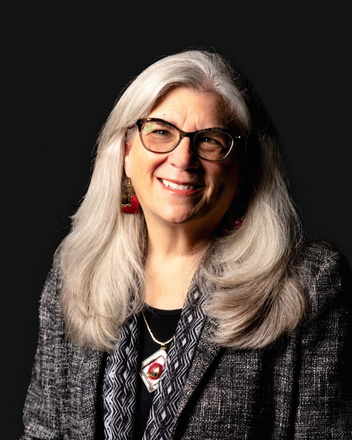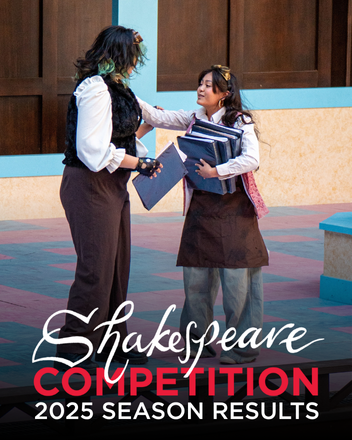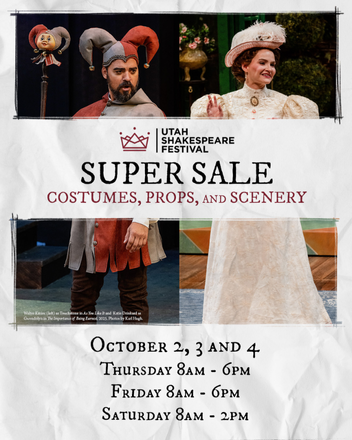News From the Festival
Over 5,000 Pounds of Food Collected for Iron County Care and Share

This fall, patrons of the Utah Shakespeare Festival contributed mightily to a worthwhile cause for the local food bank. Two and a half tons of food was collected to give to the Iron County Care and Share, more than twice what was collected during the Festival’s food drive last year. The food donations were part of our 22nd annual Fall Food Drive from September 9 to October 4, the final weeks of the Festival’s season.
In total 5,140 pounds of food was donated to help members of the local community. Residents of Iron, Washington, Kane, Garfield, Piute, and Beaver counties in Utah and Lincoln County in Nevada were encouraged to take part in the drive. They were able to donate six items of nonperishable food and receive a half-price ticket to a Festival production, with no limit on the number of half-price tickets.
“Thank you so much for this food drive that is done for us every year,” said Sara Mendoza, the Food Pantry Warehouse Manager at the Iron County Care and Share. “We’re so glad for all these donations that the community was able to raise. All this will help so many families.”
“We’re so grateful for such generosity from our patrons,” says Executive Managing Director Michael Bahr. “This community has, time and again, stepped up to help those who have such vital needs.”
The Iron County Care and Share was founded in 1984 by a group of local churches of different denominations to address the issue of hunger in our community. Working with partners in the community, neighboring counties, and in the state, the Iron County Care and Share is able to help homeless and low-income individuals and families work toward self-sufficiency. It is located at 900 North 222 West in Cedar City, Utah. Monetary donations are always accepted. Click here to donate to the organization.
Utah Shakespeare Festivals Announces Shakespeare Signature Retreat

By Liz Armstrong, guest writer
The Utah Shakespeare Festival is delighted to announce the launch of the new Shakespeare Signature Retreat for the 2026 season. An exclusive retreat for the sophisticated theatre lover, this is an event where world-class theatre meets all-inclusive luxury.
Designed to grant unparalleled insider access to the ins and outs of the Shakespeare Festival, the retreat’s ultimate goal is to foster intimacy and connection with a “journey into the very soul of our stages.”
Education Director Stewart Shelley is thrilled to offer this exclusive event to Festival patrons – comparing it to a lux “theatre land cruise, where every moment – from sunrise to curtain fall – is orchestrated to engage, inspire, and transform.”
From August 2 to August 7, 2026, the retreat will include accommodations and premiere seating at all eight productions. Three daily meals will be provided with the opportunity to dine with actors, directors, and creatives. Private backstage tours and personalized seminars will also be a major element of the retreat.
“This is the quintessential Utah Shakespeare Festival experience, where you can be carefree and relax and not have to worry about anything. We’ll take care of all the details.” Shelley said.
Unique to other Festival offerings, this retreat goes beyond a mere glimpse behind-the-scenes. Instead, it offers an immersive experience for a small, intimate group through every angle of theatre, from the costume shop to the rehearsal halls.
“We have hand-picked what to share from the 2026 season with our participants, as we’ve been working on it for nearly two years now,” Shelley continued. “We’ve been in design meetings with directors, dramaturgs, and the entire production team, and have lots of amazing experiences planned. This isn’t just a behind-the-curtain peek, but exclusive insider access.”
Shelley will be hosting the retreat alongside Instructional Coach Jim Wilcock. Availability is limited, with 20 of the 40 seats already filled. Submit an Interest Inquiry today to Education Programs Manager Sophia Bulloch to secure a spot.
“I’m thrilled for the opportunity to welcome guests into a beautifully curated week that celebrates both the artistry on our stages and the people who create it,” Bulloch said. “Designing this retreat has been incredibly meaningful, and I’m excited to watch participants step behind the scenes, engage with our artists, and experience the Festival in a uniquely personal and unforgettable way.”
For more information, visit bard.org/retreat.
What to Know about our Upcoming Cyber Sale!
With the holidays right around the corner, the Utah Shakespeare Festival is excited to announce our upcoming Cyber Sale! Check out the following FAQs to learn everything you need to know to save on 2026 Festival tickets.
$10 Off Cyber Sale FAQs
Q: How much is the discount?
A: $10 off ALL regularly priced 2026 tickets for our eight mainstage shows.
Q: When is the Cyber Sale?
A: The sale is split into two timeframes. Early Access is available by code and is available ONLINE ONLY at bard.org/plays on November 29–30, 2025. The sale for the general public will take place December 1–2, 2025 on bard.org/plays or by calling the Ticket Office at 800-PLAYTIX (752-9849), 10am to 5 pm. No code is necessary during the general sale.
Q: How do I get an Early Access code?
A: Donate $5 or more by clicking here or by calling 800-PLAYTIX (752-9849) by 5pm on November 23, 2025. Your unique code will be sent to your email on November 24, 2025, for use during the Early Access window (November 29–30).
Q: Are there any exclusions to the discount?
A: Yes, the discount excludes premier seating in any theatre, Words Cubed and RADA performances in the Anes Studio Theatre, backstage tours, and Repertory Magic. Discount cannot be combined with other promotions or applied to previous purchases.
Q: Are sales final?
A: Yes, all tickets purchased are nontransferable, nonrefundable, and cannot be exchanged.
Q: What if I have more questions?
A: For more information, please visit our website at bard.org/tickets or call our Ticket Office at 800-PLAYTIX (752-9849). The Ticket Office will be closed for the Thanksgiving holiday November 27-30, but inquiries during those days can be sent to guestservices@bard.org.
Iron County Pass FAQs
Q: What is the special offer for Iron County residents?
A: During the Cyber Sale (December 1–2, 2025 only), you will receive EIGHT (8) tickets for $200 with every Iron County Pass purchase, instead of the regular six (6) tickets. That breaks down to just $25 per show!
Q: Who can purchase an Iron County Pass?
A: Only Iron County residents can purchase. Proof of residency required.
Q: How will my Iron County residency be verified?
A: For existing patrons, we will verify residency using the address currently listed on your account. If you are a new buyer, you will be required to provide a valid Iron County address (e.g., matching the billing address on your credit card or a utility bill) when purchasing over the phone.
Q: When and how do I purchase the Iron County Pass special offer?
A: You must call the Ticket Office at 800-PLAYTIX (752-9849) between 10am and 5pm on December 1–2, 2025 only. It is not available for purchase online.
Q: Is there a limit on how many passes I can buy?
A: Yes, the Iron County Pass is limited to two per household. A household is based on the account holder’s address.
Q: What shows can I use the Iron County Pass tickets for?
A: Passes are valid only for 2026 mainstage productions.
Q: Do I have to choose the shows and dates I want to see as soon as I purchase the pass?
A: No, you do not need to select your specific performance dates right now.
Q: How do I redeem the tickets?
A: Tickets may be redeemed online using your Festival account, by calling the Ticket Office at 800-PLAYTIX (752-9849), or by visiting the Ticket Office. There is no refund if not all eight tickets are redeemed during the 2026 season, nor can tickets be saved for future seasons.
Q: Does the pass expire?
A: Yes, the pass expires on October 4, 2026.
Q: Are there any exclusions for the Iron County Pass?
A: Yes, the pass excludes premier seating in any theatre, Words Cubed and RADA performances in the Anes Studio Theatre, backstage tours, and Repertory Magic. Discount cannot be combined with other promotions or applied to previous purchases, and tickets are ineligible for exchanges or returns.
Q: What if I have other ticket questions?
A: Visit bard.org/tickets, call 800-PLAYTIX (752-9849), or email guestservices@bard.org the Ticket Office and an agent will be happy to help!
Generations Gather Here for 2026's 65th Anniversary Season
The Utah Shakespeare Festival is thrilled to officially announce its 65th Anniversary Season, which will run June 18 through October 3, 2026. “We are excited to celebrate 65 years of world-class storytelling on our stages and invite you to gather with us,” says Executive Managing Director Michael Bahr. Following a very successful 2025 season which closed the beginning of October, plans are underway for the 2026 season.
With Generations Gather Here as the seasonal inspiration, Bahr explains how this invitation is for everyone. “Ever since our inaugural year in 1961, we have had countless generations of people come together to build, share, and experience the work at the Festival. That not only includes our patrons, donors, and guests, but also our staff, artists, and volunteers, among others. So many return year after year because they are excited by the experience they’ve had when they come here. And so many come for the first time because they are intrigued by the Festival and Cedar City. We welcome all to join the legacy!”
Coming soon is the Festival’s Cyber Sale on December 1 and 2, 2025. Save $10 on every regularly priced main stage ticket for the 2026 season. To get early access before the general public, make a donation of $5 or more to the Festival by November 23 at bard.org/about/give/individual.
The 65th Anniversary Season includes, of course, works by William Shakespeare, our cornerstone playwright, as well as a variety of other plays and musicals sure to delight viewers.

Troilus and Cressida
By William Shakespeare
Engelstad Shakespeare Theatre
Last seen at the Festival in 1999, Troilus and Cressida is a rarely-done tragedy set during the Trojan War. It is a tale of love, power, survival, and betrayal and focuses on two people whose passion is tested, as war rages and loyalties shift. This play is the penultimate production for the Festival’s Complete the Canon initiative which began in 2012, a commitment to produce every one of Shakespeare’s works.
Directing is Carolyn Howarth, a returning artist who helmed last season’s Antony and Cleopatra as well as The Winter’s Tale in 2024. Her amazing work has also been seen at Colorado Shakespeare Festival where she spent 14 seasons. She has also directed at Orlando Shakespeare Theatre, Lake Tahoe Shakespeare Festival, and Foothill Theatre Company where she served as artistic director. She earned her BA and MFA from UC-Davis and is a member of Actors’ Equity Association.
“I love the satiric tone of this rarely-performed play and how it takes aim at our Romantic and Heroic ideals, at political leadership, at the War Machine, and really takes those notions down a notch,” says Howarth. “In those terms it feels like a play that could have been written yesterday. It is at times very funny, sometimes tragic, with singing and swordplay––one gets a little of everything!”
Troilus and Cressida previews on June 18, 2026, and runs through September 3, 2026.

Hamlet
By William Shakespeare
Engelstad Shakespeare Theatre
As one of Shakespeare’s most haunting and well-known tragedies, Prince Hamlet wrestles with the death of his father as well as with his own inaction, while searching for truth and harnessing his desire for vengeance. He spirals into crisis and isolation, exemplifying the complexities of the human condition. Last seen on Festival stages in 2019, it is one of the most popular of Shakespeare’s plays produced here.
Returning director Beth Lopes will lead the 2026 production of Hamlet after having directed As You Like It this past season. She also assistant directed at the Festival in 2010 after which she spent ten seasons directing at New Swan Shakespeare Festival where she is an associate artistic director. Her work has also been featured at South Coast Repertory, San Antonio Shakespeare in the Park, and Theatre Horizon. She received her MFA from UC Irvine and is a member of Stage Directors and Choreographers Society (SDC).
“There are many different stories to tell within Hamlet, but the element that I’m most excited to share in the 2026 season focuses on Hamlet’s haunting,” says Lopes. “Our beloved Dane’s past and present obligations of duty are personified in the ghost of his father, a painful reminder of what has transpired, but also a dreadful harbinger of what’s to come.”
Hamlet previews on June 19, 2026, and runs through September 4, 2026.

Twelfth Night
By William Shakespeare
Engelstad Shakespeare Theatre
Believed to have been written as a commissioned piece for Queen Elizabeth, Twelfth Night was performed during the holiday season festivities of 1601-02. It’s a beloved comedy, last featured at the Festival in 2019, that includes a complicated love triangle, mistaken identities, mischief, and witty banter that proves love often finds us when––and where––we least expect it.
The Festival’s Artistic Director John DiAntonio returns to direct Twelfth Night. He previously directed Macbeth in 2025 in addition to performing as Jack in Ken Ludwig’s Dear Jack, Dear Louise and Petruchio in 2024’s The Taming of the Shrew. Prior to coming to Cedar City, he was the producing artistic director at Creede Repertory Theatre. Additional acting and directing credits include the Denver Center Theatre Company, The Arvada Center, and Cleveland Shakespeare Festival. He received his MFA in acting from the National Theatre Conservatory and also attended the British American Drama Academy. He is a member of Actors’ Equity Association.
“Twelfth Night was the first Shakespeare play I ever saw performed live, and I was instantly enchanted. I remember sitting in the park and falling in love with every character. It’s rare in Shakespeare to feel that affection for an entire ensemble, but this play invites it. Twelfth Night is truly an ensemble — joyful, generous, and full of heart.”
Twelfth Night previews on June 20, 2026 and runs through September 5, 2026.

Something Rotten!
Book by Karey Kirkpatrick and John O’Farrell
Music and Lyrics by Wayne Kirkpatrick and Karey Kirkpatrick
Conceived by Karey Kirkpatrick and Wayne Kirkpatrick
Having premiered on Broadway in 2015, Something Rotten! is a hilarious, high-energy musical that reimagines Shakespeare’s world with modern twists. Set in the Renaissance, it follows struggling playwrights Nick and Nigel Bottom, who try to outshine wildly popular William Shakespeare by creating the world’s first musical. Packed with show-stopping numbers, outrageous comedy, and clever nods to Broadway and the Bard, this show celebrates creativity, ambition, and the absurdity of the theatre world.
Returning to the Festival is two-time Emmy Award-winning director, artist, and producer Alan Muraoka, who helmed a special Festival production of Gold Mountain in 2021. As an actor, he performed on Broadway seven times, including Disney’s Aladdin, The King and I, and Miss Saigon, as well as 27 years as Alan on Sesame Street. He was resident director of Off-Broadway’s Avenue Q, and his directing work has been featured at Olney Theatre, Dallas Theatre Center, and Pioneer Theatre Company. He earned his BFA from UCLA and has received numerous awards including a GLAAD Media Award and Carol Burnett Musical Comedy Award.
“Something Rotten feels like the perfect show for Festival audiences. At its core it is an old-fashioned musical, complete with catchy tunes, fast-paced comedy, and even tap dancing!” says Muraoka. “And with Shakespeare and his works as a central theme, theatre lovers will be tuned in to all the clever references that are sprinkled throughout this delightful romp. I’m so thrilled to be able to share it with audiences of all ages.”
Something Rotten! previews on June 22, 2026 and runs through October 3, 2026.

See How They Run
By Philip King
See How They Run is packed with mistaken identities, unexpected visitors, and nonstop chaos. Set in a quiet English vicarage during WWII, the play spirals into comedic mayhem as a soldier, a German POW, a Russian spy, and multiple clergymen, converge on the house. Written to boost morale during wartime, this fast-paced comedy delivers delightful confusion and wild fun for audiences of all ages.
Directed by Festival veteran Geoffrey Kent, See How They Run is a classic British farce never before seen on Festival stages. Patrons will recognize Kent from his acting roles this past season as Mark Antony in Antony and Cleopatra, Duke Frederick in As You Like It, and various roles in Macbeth. He also directed The Play That Goes Wrong in 2023, and has served as Fight Director and acted in numerous shows since 2009. His work has also been seen at DCPA Broadway, Colorado Shakespeare Festival, and Arvada Center, among others. He has taught at University of Northern Colorado and University of Denver, and is a member of Actors’ Equity Association (AEA) and Stage Directors and Choreographers Society (SDCS).
“Farce is my favorite style of theatre to create, it demands honesty, pace, and killer timing,” says Kent. “I hope audiences remember to bring tissues because we indend to make you cry from laughing.”
See How They Run previews on June 23, 2026 and runs through September 4, 2026.

She Loves Me
Book by Joe Masteroff
Music by Jerry Bock
Lyrics by Sheldon Harnick
Based on a play by Miklós László
In She Loves Me, the main characters Georg and Amalia are feuding co-workers in a 1930s perfume shop, and each is falling in love with their anonymous pen pal. Based on the same play that inspired the films The Shop Around the Corner and You’ve Got Mail, this charming, heartwarming musical sparkles with witty dialogue, endearing characters, and a beautiful score by Harnick and Bock (Fiddler on the Roof). It’s a delightful feel-good story of second chances and love discovered in surprising ways.
Michael Perlman returns to USF this year to direct She Loves Me after directing last season’s Ken Ludwig’s Dear Jack, Dear Louise. A New York-based writer and director, his work has been seen at Goodspeed Opera House, Cleveland Playhouse, Boise Contemporary Theatre, and Creede Repertory Theatre among others. He has been associate director for Noises Off on Broadway and at off-Broadway’s Roundabout Theatre, Barrow Street, and the Public Theatre. He has taught at Juilliard School of Drama as well as Brown University where he earned his BA and MFA. He is a member of Stage Directors and Choreographers Society (SDC) and is a Drama League Directing Fellow.
“She Loves Me is one of those rare perfect musicals in which everything seamlessly comes together for an evening of true heartfelt storytelling.” says Perlman. “It’s a musical that people either know and love or don’t know at all, and so I’m thrilled to be able to bring it to life for those who love it and for those who have yet to see it. It’s filled with characters who amidst all the struggles in their lives are yearning for and seeking love, and ultimately remind us that we may find love where we least expect it.”
She Loves Me previews on June 24, 2026, and runs through October 3, 2026.

Mary Shelley’s Frankenstein
By David Catlin
Based on the book by Mary Shelley
Eileen and Allen Anes Studio Theatre
David Catlin’s adaptation of Mary Shelley’s classic novel Frankenstein weaves together the haunting tale of Victor Frankenstein and his creation with the real-life circumstances that inspired Mary Shelley to write it. Blending fiction and reality, the play delves into the depths of human ambition, the consequences of scientific pursuit, and the blurred line between creator and creation, offering a profoundly human and contemporary take on a timeless story.
Directing this bold retelling of the Gothic masterpiece is Risa Brainin, who is making her Utah Shakespeare Festival debut in 2026. She is a freelance director and Founder/Artistic Director of LAUNCH PAD, a new play development program at UC Santa Barbara. She served as Artistic Director of Shakespeare Santa Cruz, Associate Artistic Director at both Indiana Repertory Theatre and Kansas City Repertory Theatre, and Resident Director of the Guthrie Theater. Directing credits include The Acting Company, Alabama Shakespeare Festival, and Denver Center Theatre, among others. A graduate of the Carnegie Mellon University Drama Program, Brainin is a member of the National Theatre Conference and the College of Fellows of the American Theatre.
“One of the things I love most is that as the play goes on the Creature becomes more human, and Victor Frankenstein, the creator who ruthlessly abandons his creation, becomes more monstrous,” says Brainin. “The question that continually intrigues me is what is one’s responsibility to one’s creation and its life thereafter? With the growing use of AI, that question cannot be any more pressing than it is right now. The innovations of today will affect everything about tomorrow. So, what is our responsibility to the future?”
Mary Shelley’s Frankenstein previews on July 13, 2026, and runs through October 3, 2026.

The Book Club Play
By Karen Zacarías
Eileen and Allen Anes Studio Theatre
The Book Club Play is described like “Lord of the Flies with wine and dip,” and is a comedy about a tight-knit group of friends whose carefully curated lives unravel when their book club becomes the subject of a documentary. As tensions rise and secrets emerge, the laughs build in this witty satire about literature, the chaos of group dynamics, and the stories we tell ourselves, proving real life is often the most unpredictable plot of all.
Veteran Festival actor Matt Zambrano returns to direct The Book Club Play. Audiences may remember him in Scapin in 2012 and Peter and the Starcatcher in 2013, among others. His work has also been seen all over the country, including at Shakespeare Theater of D.C., Milwaukee Rep, Colorado Shakespeare Festival, and The Denver Center Theater. Other credits include the film The People vs. George Lucas, the web series Orcs of New York, the podcast Story Pirates, and teaching at Disney Theatrical Group, among many others. He received his MFA from National Theater Conservatory and is a member of Actors’ Equity Association.
“I love working on Karen’s plays,” says Zambrano. “She is so good at writing comedies with real, three-dimensional people and I can’t wait for audiences to experience The Book Club Play. It’s rare that a script makes me laugh out loud even after I’ve read it before, but every time I come back to this play, I find a new line or moment that manages to tickle my funny bone.”
The Book Club Play previews July 14, 2026, and runs through October 3, 2026.

The Greenshow
Prepare for delightful summer evenings of stories, music, and dance with three new shows on the green. Written by Festival veteran Britannia Howe and directed by returning artist Trey Plutnicki, both of whom have long histories with the Festival, these shows are the perfect way to get in a theatrical mood before the mainstage evening shows.
A Cedar City native, Howe grew up attending the Festival. She earned a MFA in directing from Illinois State University and has directed at Illinois Shakespeare Festival, Eugene O’Neill Theatre Center, and with the Utah Symphony. She was awarded a national directing fellowship from the Kennedy Center American College Theatre Festival. She has written and directed The Greenshow six times in the last eight years, and is currently a Theatre Arts faculty member at Southern Utah University.
Plutnicki returns to direct and choreograph The Greenshow after serving as choreographer for The Greenshow and various mainstage shows in 2024 and 2025, and as a member of the acting company in 2019 and 2021. He has also worked with Drury Lane Productions, Hunterdon Hills Playhouse, Rocky Mountain Repertory Theatre, and Otterbein Summer Theatre.
“The Greenshow was my introduction to the Festival in 2019. Like many patrons of USF, it was the gateway to my love of Shakespeare, the Festival, and the Cedar City community,” says Plutnicki. “This year, I hope to share the love I’ve felt over the past seven years.”
The themes for the three 2026 Greenshows will be Stratford Night, Americana Night, and Celtic Night. The Greenshow previews on June 18, 2026, and runs through September 5, 2026.
2026 Directors in the Randall L. Jones Theatre
The Utah Shakespeare Festival is excited to announce the shows and directors for the Randall L. Jones Theatre for the upcoming 2026 season. “We are thrilled to be featuring not one, but two musicals next season, pairing perfectly with an English farcical comedy. The Randall shows will be a riot next year!” says Artistic Director John DiAntonio.
That’s right! Two musicals in the lineup, and one very fast-paced farce, all to bring joy and delight!

Something Rotten!
Book by Karey Kirkpatrick and John O’Farrell
Music and Lyrics by Wayne Kirkpatrick and Karey Kirkpatrick
Conceived by Karey Kirkpatrick and Wayne Kirkpatrick
Returning to the Festival is two-time Emmy Award-winning director, artist, and producer Alan Muraoka, who helmed a special Festival production of Gold Mountain in 2021. As an actor, he performed on Broadway seven times, including Disney’s Aladdin, The King and I, and Miss Saigon, as well as 27 years as Alan on Sesame Street. He was resident director of Off-Broadway’s Avenue Q, and his directing work has been featured at Olney Theatre, Dallas Theatre Center, and Pioneer Theatre Company. He earned his BFA from UCLA and has received numerous awards including a GLAAD Media Award and Carol Burnett Musical Comedy Award.
Having premiered on Broadway in 2015, Something Rotten! is a hilarious, high-energy musical that reimagines Shakespeare’s world with modern twists. Set in the Renaissance, it follows struggling playwrights Nick and Nigel Bottom, who try to outshine wildly popular William Shakespeare by creating the world’s first musical. Packed with show-stopping numbers, outrageous comedy, and clever nods to Broadway and the Bard, this show celebrates creativity, ambition, and the absurdity of the theatre world.
“Something Rotten feels like the perfect show for Festival audiences. At its core it is an old-fashioned musical, complete with catchy tunes, fast-paced comedy, and even tap dancing!” says Muraoka. “And with Shakespeare and his works as a central theme, theatre lovers will be tuned in to all the clever references that are sprinkled throughout this delightful romp. I’m so thrilled to be able to share it with audiences of all ages.”
Something Rotten! previews on June 22, 2026 and runs through October 3, 2026.

See How They Run
By Philip King
Directed by Festival veteran Geoffrey Kent, See How They Run is a classic British farce never before seen on Festival stages. Patrons will recognize Kent from his acting roles this past season as Mark Antony in Antony and Cleopatra, Duke Frederick in As You Like It, and various roles in Macbeth. He also directed The Play That Goes Wrong in 2023, and has served as Fight Director and acted in numerous shows since 2009. His work has also been seen at DCPA Broadway, Colorado Shakespeare Festival, and Arvada Center, among others. He has taught at University of Northern Colorado and University of Denver, and is a member of Actors’ Equity Association (AEA) and Stage Directors and Choreographers Society (SDCS).
See How They Run is packed with mistaken identities, unexpected visitors, and nonstop chaos. Set in a quiet English vicarage during WWII, the play spirals into comedic mayhem as a soldier, a German POW, a Russian spy, and multiple clergymen, converge on the house. Written to boost morale during wartime, this fast-paced comedy delivers delightful confusion and wild fun for audiences of all ages.
“Farce is my favorite style of theatre to create, it demands honesty, pace, and killer timing,” says Kent. “I hope audiences remember to bring tissues because we indend to make you cry from laughing.”
See How They Run previews on June 23, 2026 and runs through September 4, 2026.

She Loves Me
Book by Joe Masteroff
Music by Jerry Bock
Lyrics by Sheldon Harnick
Based on a play by Miklós László
Michael Perlman returns to USF this year to direct She Loves Me after directing last season’s Ken Ludwig’s Dear Jack, Dear Louise. A New York-based writer and director, his work has been seen at Goodspeed Opera House, Cleveland Playhouse, Boise Contemporary Theatre, and Creede Repertory Theatre among others. He has been associate director for Noises Off on Broadway and at off-Broadway’s Roundabout Theatre, Barrow Street, and the Public Theatre. He has taught at Juilliard School of Drama as well as Brown University where he earned his BA and MFA. He is a member of Stage Directors and Choreographers Society (SDC) and is a Drama League Directing Fellow.
In She Loves Me, the main characters Georg and Amalia are feuding co-workers in a 1930s perfume shop, and each is falling in love with their anonymous pen pal. Based on the same play that inspired the films The Shop Around the Corner and You’ve Got Mail, this charming, heartwarming musical sparkles with witty dialogue, endearing characters, and a beautiful score by Harnick and Bock (Fiddler on the Roof). It’s a delightful feel-good story of second chances and love discovered in surprising ways.
“She Loves Me is one of those rare perfect musicals in which everything seamlessly comes together for an evening of true heartfelt storytelling.” says Perlman. “It’s a musical that people either know and love or don’t know at all, and so I’m thrilled to be able to bring it to life for those who love it and for those who have yet to see it. It’s filled with characters who amidst all the struggles in their lives are yearning for and seeking love, and ultimately remind us that we may find love where we least expect it.”
She Loves Me previews on June 24, 2026 and runs through October 3, 2026.
Don’t miss our 65th season in 2026! Be sure to get your tickets on sale during our Cyber Sale event on December 1 and 2 and join us in 2026 for a season of love, humor, and surprise. For more information visit our website at bard.org or call the Ticket Office at 800-PLAYTIX.
2026 Directors in the Anes Studio Theatre
The Utah Shakespeare Festival is thrilled to announce the directors for the shows in the Eileen and Allen Anes Studio Theatre for the 2026 season. “These two amazing directors are so excited to come to the Festival and tackle these shows in this beloved space, for our celebratory sixty-fifth season. I can’t wait for our guests to experience them!” says Artistic Director John DiAntonio.
Productions in the Anes Studio Theatre are favorites of our patrons because of the intimate nature of the space: with only 200 seats, it provides an up close and personal experience to remember for a lifetime!

Mary Shelley’s Frankenstein
By David Catlin
Based on the book by Mary Shelley
Directing this bold retelling of the Gothic masterpiece is Risa Brainin, who is making her Utah Shakespeare Festival debut in 2026. She is a freelance director and Founder/Artistic Director of LAUNCH PAD, a new play development program at UC Santa Barbara. She served as Artistic Director of Shakespeare Santa Cruz, Associate Artistic Director at both Indiana Repertory Theatre and Kansas City Repertory Theatre, and Resident Director of the Guthrie Theater. Directing credits include The Acting Company, Alabama Shakespeare Festival, Cincinnati Playhouse in the Park, Denver Center Theatre, Gulfshore Playhouse, Pittsburgh Public Theater, Repertory Theatre of St. Louis, and Syracuse Stage among others. A graduate of the Carnegie Mellon University Drama Program, Brainin is a member of the National Theatre Conference and the College of Fellows of the American Theatre.
David Catlin’s adaptation of Mary Shelley’s classic novel Frankenstein weaves together the haunting tale of Victor Frankenstein and his creation with the real-life circumstances that inspired Mary Shelley to write it. Blending fiction and reality, the play delves into the depths of human ambition, the consequences of scientific pursuit, and the blurred line between creator and creation, offering a profoundly human and contemporary take on a timeless story.
“One of the things I love most is that as the play goes on the Creature becomes more human, and Victor Frankenstein, the creator who ruthlessly abandons his creation, becomes more monstrous,” says Brainin. “The question that continually intrigues me is what is one’s responsibility to one’s creation and its life thereafter? With the growing use of AI, that question cannot be any more pressing than it is right now. The innovations of today will affect everything about tomorrow. So, what is our responsibility to the future?”
Mary Shelley’s Frankenstein previews on July 13, 2026, and runs through October 3, 2026.

The Book Club Play
By Karen Zacarías
Veteran Festival actor Matt Zambrano returns to direct The Book Club Play. Audiences may remember him in Scapin in 2012 and Peter and the Starcatcher in 2013, among others. His work has also been seen all over the country, including at Shakespeare Theater of D.C., Milwaukee Rep, Creede Repertory Theater, Colorado Shakespeare Festival, The Denver Center Theater, and Edinburgh Fringe Festival. Other credits include the film The People vs. George Lucas, the web series Orcs of New York, the podcast Story Pirates, and teaching at Disney Theatrical Group, among many others. He received his MFA from National Theater Conservatory and is a member of Actors’ Equity Association.
The Book Club Play is described like “Lord of the Flies with wine and dip,” and is a comedy about a tight-knit group of friends whose carefully curated lives unravel when their book club becomes the subject of a documentary. As tensions rise and secrets emerge, the laughs build in this witty satire about literature, the chaos of group dynamics, and the stories we tell ourselves, proving real life is often the most unpredictable plot of all.
“I love working on Karen’s plays,” says Zambrano. “She is so good at writing comedies with real, three-dimensional people and I can’t wait for audiences to experience The Book Club Play. It’s rare that a script makes me laugh out loud even after I’ve read it before, but every time I come back to this play I find a new line or moment that manages to tickle my funny bone.”
The Book Club Play previews July 14, 2026, and runs through October 3, 2026.
Don’t miss our upcoming Cyber Monday sale on December 1 and 2 and join us in 2026 for a thrilling and delightful season! For more information including content advisories, visit our website at bard.org or call the Ticket Office at 800-PLAYTIX, Monday through Friday, noon to 5pm. No window service is available until next spring.
2026 Directors in the Engelstad Shakespeare Theatre
The Utah Shakespeare Festival is excited to announce the directors for the Engelstad Shakespeare Theatre shows and The Greenshow for the 2026 season. “We are thrilled to share with you these amazing artists who will head our Shakespeare productions and popular Greenshows for our celebratory sixty-fifth season,” says Executive Managing Director Michael Bahr.
With Shakespeare as our cornerstone, the Festival is excited to produce three of his amazing stories, all very unique from each other and one which hasn’t been done here since 1999. Get ready for the family-friendly Greenshow and Shakespeare under the stars in the Engelstad Theatre!
ON THE ENGELSTAD SHAKESPEARE THEATRE STAGE

Troilus and Cressida
By William Shakespeare
Directing the seldom done tragedy Troilus and Cressida is Carolyn Howarth, a returning artist who directed last season’s Antony and Cleopatra as well as The Winter’s Tale in 2024. Her amazing work has also been seen at Colorado Shakespeare Festival where she spent 14 seasons. She has also directed at Orlando Shakespeare Theatre, Lake Tahoe Shakespeare Festival, and Foothill Theatre Company where she served as artistic director. She earned her BA and MFA from UC-Davis and is a member of Actors’ Equity Association.
Troilus and Cressida is a tragic tale of love, power, survival, and betrayal set during the Trojan War. It focuses on two people whose passion is tested, as war rages and loyalties shift. This play is the second-to-last production for the Complete the Canon initiative which began in 2012, when the Festival committed to produce every one of Shakespeare’s works.
“I love the satiric tone of this rarely-performed play and how it takes aim at our Romantic and Heroic ideals, at political leadership, at the War Machine, and really takes those notions down a notch,” says Howarth. “In those terms it feels like a play that could have been written yesterday. It is at times very funny, sometimes tragic, with singing and swordplay––one gets a little of everything!”
Troilus and Cressida previews on June 18, 2026, and runs through September 3, 2026.

Hamlet
By William Shakespeare
Returning director Beth Lopes will lead the 2026 production of Hamlet after having directed As You Like It last season. She also assistant directed at the Festival in 2010 after which she spent ten seasons directing at New Swan Shakespeare Festival where she is an associate artistic director. Her work has also been featured at South Coast Repertory, San Antonio Shakespeare in the Park, and Theatre Horizon. She received her MFA from UC Irvine and is a member of Stage Directors and Choreographers Society (SDC).
Hamlet is one of the most produced Shakespeare plays at the Festival. The well-known tragedy finds Prince Hamlet struggling with the sudden death of his father. He spirals into crisis, isolation, and a convoluted relationship with vengeance, exemplifying the complexities of the human condition.
“There are many different stories to tell within Hamlet, but the element that I’m most excited to share in the 2026 season focuses on Hamlet’s haunting,” says Lopes. “Our beloved Dane’s past and present obligations of duty are personified in the ghost of his father, a painful reminder of what has transpired, but also a dreadful harbinger of what’s to come.”
Hamlet previews on June 19, 2026, and runs through September 4, 2026.

Twelfth Night
By William Shakespeare
The Festival’s Artistic Director John DiAntonio returns as a director in 2026, helming the popular comedy Twelfth Night. He previously directed Macbeth last season in addition to performing as Jack in Ken Ludwig’s Dear Jack, Dear Louise and Petruchio in 2024’s The Taming of the Shrew. Prior to coming to Cedar City, he was the producing artistic director at Creede Repertory Theatre. Additional acting and directing credits include the Denver Center Theatre Company, The Arvada Center, and Cleveland Shakespeare Festival. He received his MFA in acting from the National Theatre Conservatory and also attended the British American Drama Academy. He is a member of Actors’ Equity Association.
Twelfth Night is a beloved comedy, last featured at the Festival in 2019, that includes a complicated love triangle, mistaken identities, mischief, and witty banter that proves love often finds us when––and where––we least expect it.
“Twelfth Night was the first Shakespeare play I ever saw performed live, and I was instantly enchanted. I remember sitting in the park and falling in love with every character. It’s rare in Shakespeare to feel that affection for an entire ensemble, but this play invites it. Twelfth Night is truly an ensemble — joyful, generous, and full of heart.”
Twelfth Night previews on June 20, 2026 and runs through September 5, 2026.
ON THE GREENSHOW STAGE

The Greenshow
Prepare for delightful summer evenings of stories, music, and dance with three new shows on the green in 2026. Directed by returning artist Trey Plutnicki and written by Festival veteran Britannia Howe, both of whom have long histories with the Festival, these shows are the perfect way to get in a theatrical mood before the mainstage evening shows.
Plutnicki returns to direct and choreograph The Greenshow after serving as choreographer for The Greenshow and various mainstage shows in 2024 and 2025, and as a member of the acting company in 2019 and 2021. He has also worked with Drury Lane Productions, Hunterdon Hills Playhouse, Rocky Mountain Repertory Theatre, and Otterbein Summer Theatre.
A Cedar City native, Howe grew up attending the Festival. She earned a MFA in directing from Illinois State University and has directed at Illinois Shakespeare Festival, Eugene O’Neill Theatre Center, and with the Utah Symphony. She was awarded a national directing fellowship from the Kennedy Center American College Theatre Festival. She has written and directed The Greenshow six times in the last eight years, and is currently a Theatre Arts faculty member at Southern Utah University.
“The Greenshow was my introduction to the Festival in 2019. Like many patrons of USF, it was the gateway to my love of Shakespeare, the Festival, and the Cedar City community,” says Plutnicki. “This year, I hope to share the love I’ve felt over the past seven years.”
The themes for the three 2026 Greenshows will be “Stratford Night” with a focus on Shakespeare, “Americana Night” celebrating the 250th birthday of the United States, and “Celtic Night” featuring traditional Irish and Scottish music, dance, and lore.
The Greenshow previews on June 18, 2026, and runs through September 5, 2026.
Be sure not to miss our upcoming Cyber Monday sale on December 1 and 2 and join us in 2026 for a thrilling and delightful season! For more information, visit our website at bard.org or call the Ticket Office at 800-PLAYTIX.
Utah Shakespeare Festival Announces 65th Anniversary Season for 2026
The Utah Shakespeare Festival is thrilled to officially announce its 65th Anniversary Season, which will run June 18 through October 3, 2026. “We are excited to celebrate our 65th year of world-class storytelling on our stages and invite you to gather with us,” says Artistic Director John DiAntonio.
With Generations Gather Here as the seasonal inspiration, DiAntonio explains how this invitation is for everyone. “Ever since our inaugural year in 1961, we have had countless generations of people come together to build, share, and experience the work at the Festival. That not only includes our patrons, donors, and guests, but also our staff, artists, and volunteers, among others. So many return year after year because they are excited by the experience they’ve had when they come here. And so many come for the first time because they are intrigued by the Festival and Cedar City. We welcome all to join the legacy!”
The 65th Anniversary Season includes, of course, works by William Shakespeare, our cornerstone playwright, as well as a variety of other plays and musicals sure to delight viewers.
Troilus and Cressida
By William Shakespeare
Engelstad Shakespeare Theatre
Previews June 18, 2026
Runs June 22 - September 3, 2026
Last seen at the Festival in 1999, Troilus and Cressida is a rarely-done tragedy set during the Trojan War. It is a tale of love, power, survival, and betrayal and focuses on two people whose passion is tested, as war rages and loyalties shift. This play is the penultimate production for the Festival’s Complete the Canon initiative which began in 2012, a commitment to produce every one of Shakespeare’s works.
Hamlet
By William Shakespeare
Engelstad Shakespeare Theatre
Previews June 19, 2026
Runs June 23 - September 4, 2026
As one of Shakespeare’s most haunting and well-known tragedies, Prince Hamlet wrestles with the death of his father as well as with his own inaction, while searching for truth and harnessing his desire for vengeance. He spirals into crisis and isolation, exemplifying the complexities of the human condition. Last seen on Festival stages in 2019, it is one of the most popular of Shakespeare’s plays produced here.
Twelfth Night
By William Shakespeare
Engelstad Shakespeare Theatre
Previews June 20, 2026
Runs June 24 - September 5, 2026
Believed to have been written as a commissioned piece for Queen Elizabeth, Twelfth Night was performed during the holiday season festivities of 1601-02. It’s a beloved comedy, last featured at the Festival in 2019, that includes a complicated love triangle, mistaken identities, mischief, and witty banter that proves love often finds us when––and where––we least expect it.
Something Rotten!
Book by Karey Kirkpatrick and John O’Farrell
Music and Lyrics by Wayne Kirkpatrick and Karey Kirkpatrick
Conceived by Karey Kirkpatrick and Wayne Kirkpatrick
Randall L. Jones Theatre
Previews June 22, 2026
Runs June 29 - October 3, 2026
Having premiered on Broadway in 2015, Something Rotten! is a hilarious, high-energy musical that reimagines Shakespeare’s world with modern twists. Set in the Renaissance, it follows struggling playwrights Nick and Nigel Bottom, who try to outshine wildly popular William Shakespeare by creating the world’s first musical. Packed with show-stopping numbers, outrageous comedy, and clever nods to Broadway and the Bard, this show celebrates creativity, ambition, and the absurdity of the theatre world.
See How They Run
By Philip King
Randall L. Jones Theatre
Previews June 23, 2026
Runs June 30 - September 4, 2026
See How They Run is a classic British farce never before seen at the Festival, packed with mistaken identities, unexpected visitors, and nonstop chaos. Set in a quiet English vicarage during WWII, the play spirals into comedic mayhem as a soldier, a German POW, a Russian spy, and multiple clergymen, converge on the house. Written to boost morale during wartime, this fast-paced comedy delivers delightful confusion and wild fun for audiences of all ages.
She Loves Me
Book by Joe Masteroff
Music by Jerry Bock
Lyrics by Sheldon Harnick
Based on a play by Miklós László
Randall L. Jones Theatre
Previews June 24, 2026
Runs July 1 to October 3, 2026
Georg and Amalia are feuding co-workers in a 1930s perfume shop, and each is falling in love with their anonymous pen pal. Based on the same play that inspired the films The Shop Around the Corner and You’ve Got Mail, this charming, heartwarming musical sparkles with witty dialogue, endearing characters, and a beautiful score by Harnick and Bock (Fiddler on the Roof). It’s a delightful feel-good story of second chances and love discovered in surprising ways.
Mary Shelley’s Frankenstein
By David Catlin
Based on the book by Mary Shelley
Eileen and Allen Anes Studio Theatre
Previews July 13, 2026
Runs July 17 - October 3, 2026
A riveting and bold retelling of the Gothic masterpiece about Victor Frankenstein and his creation, told through the lens of Mary Shelley’s own tragic story. Deeply human, it explores ambition, the impact of scientific progress, and the intertwined nature of master and monster in a fresh perspective on this literary classic.
The Book Club Play
By Karen Zacarías
Eileen and Allen Anes Studio Theatre
Previews July 14, 2026
Run July 18 - October 3, 2026
This clever comedy tells of a tight-knit group of friends whose carefully curated lives unravel when their book club becomes the subject of a documentary. As tensions rise and secrets emerge, the laughs build in this witty satire about literature, the chaos of group dynamics, and the stories we tell ourselves, proving real life is often the most unpredictable plot of all.
For more information including content advisories, please visit bard.org. Tickets are available for purchase online or by calling the Ticket Office at 800-PLAYTIX, Monday through Friday, noon to 5pm. No window service is available until next spring.
Results of the 2025 Shakespeare Competition

This past weekend the Utah Shakespeare Festival and Southern Utah University hosted the 48th annual Shakespeare Competition where dozens of awards and scholarships were given to drama, dance, and music students.
The competition is the largest scholastic Shakespeare competition in North America, and this year, over 3,000 students from 102 schools attended from Utah, Arizona, Nevada, California, Colorado, and Wisconsin. More than 300 coaches and teachers helped prepare these students for the competition.
From October 2 to 4, students competed before numerous adjudicators on the Festival’s stages and on SUU’s campus. More than 80 judges consisting of arts professionals with strong literary and performance backgrounds, including company members from the 2025 season at the Festival, provided feedback to participants.
The competition recognizes and educates students between second and twelfth grade in four areas: acting, dance/choreography, music, and technical theatre. At the conclusion of the competition, selected students received trophies, plaques, and scholarships to study with professionals at Southern Utah University and the Utah Shakespeare Festival.
The competition is divided into six divisions: Buckingham (large schools), Oxford (medium schools), Cambridge (medium small schools), Westminster (small schools), Stratford (junior high and middle schools) and Essex (schools or groups which are not members of state high school associations).
Education Director Stewart Shelley is thrilled with how this year’s competition went. “This weekend has been truly inspiring, seeing so many young people deeply engaged with Shakespeare and theatre. It’s an honor to witness the exceptional work showcased throughout the competition and to watch students thrive, surrounded by peers who share their passion and dedication.”
ACTING COMPETITION
For the acting portion of the competition, students compete in monologues, duo/trio scenes, and ensembles. Monologue competitors present a two- to four-minute monologue from a Shakespeare play or sonnet for the judges. In the duo/trio scenes competition, two or three actors present a three- to five-minute scene from a Shakespeare play or sonnet. In the ensemble competition, a group of students from a school present a six- to ten-minute Shakespearean scene.
In addition, first, second, and third place overall sweepstake prizes were awarded to the school in each division with the most total points from all categories.
Also, several scholarships are presented in the acting competition.
The first place winners in the duo/trio scene and monologue categories are awarded scholarships to either Southern Utah University or the Utah Shakespeare Festival summer classes, depending on the grade of the student.
Ray Jones Award: Given to seniors, this award is a $1,000 scholarship to Southern Utah University.
Barbara Barrett Award: Given to juniors and under, this award is a $500 scholarship to the Festival’s summer acting intensive Actor Training Camp or Junior Actor Training Camp.
Larry Lott Acting Award: In conjunction with the ensemble competition, judges annually recognize the best actor in an ensemble scene in each division. The recipient of this award received a trophy for his or her accomplishments and, if a senior, a $1,000 scholarship to SUU.
Here are the winners for the Acting Competition.
BUCKINGHAM DIVISION
Sweepstakes First Place: Skyridge High School Sweepstakes Second Place: Westlake High School Sweepstakes Third Place: American Fork High School
Ensemble First Place: Skyridge High School Ensemble Second Place: American Fork High School Ensemble Third Place: Riverton High School
Duo/Trio Scenes First Place: Liam Huff and Lily Neff from Taylorsville High School Duo/Trio Scenes Second Place: Emma Peart and Nate Myers from Westlake High School Duo/Trio Scenes Third Place: Haley Forsloff, Michael Jowett and Savanna Hull from Skyridge High School
Monologue First Place: Layna Johnson from Alta High School Monologue Second Place: Kylie Priday from Westlake High School Monologue Third Place: Kamryn Donio from Mountain Ridge High School
Barbara Barrett Award: Liam Huff and Lily Neff from Taylorsville High School Larry Lott Acting Award: AnnaBelle Taylor from Skyridge High School
OXFORD DIVISION
Sweepstakes First Place: Hillcrest High School Sweepstakes Second Place: Brighton High School Sweepstakes Third Place: Corner Canyon High School
Ensemble First Place: Corner Canyon High School Ensemble Second Place: Hillcrest High School Ensemble Third Place: Brighton High School
Duo/Trio Scenes First Place: Airton Oliveira, Camille Fisher, and Sophia Magleby from Brighton High School Duo/Trio Scenes Second Place: Gabe Abbott, Gideon Kirby, and Jordan Cecil from Hillcrest High School Duo/Trio Scenes Third Place: Cooper Runnells, Ginger Witkamp, and Henry Jeppeson from Hillcrest High School
Monologue First Place: Avery Rinke from Hillcrest High School Monologue Second Place: Alicia Cerda from Northridge High School Monologue Third Place: Brooklyn Lowell from Northridge High School
Ray Jones Award: Camille Fisher and Sophia Magleby from Brighton High School Barbara Barrett Award: Airton Oliveira from Brighton High School Larry Lott Acting Award: Vienna Van Dyke from Timpview High School
CAMBRIDGE DIVISION
Sweepstakes First Place: North Sanpete High School Sweepstakes Second Place: Canyon View High School Sweepstakes Third Place: Orem High School
Ensemble First Place: North Sanpete High School Ensemble Second Place: Orem High School Ensemble Third Place: Canyon View High School
Duo/Trio Scenes First Place: Olivia Tenney and Saxton Ballard from Hurricane High School Duo/Trio Scenes Second Place: Andy Larsen, Aspen Tui, and Declan Mathews from North Sanpete High School Duo/Trio Third Place: Adelaide Call, Rose Despain, and Sarah Allred from Canyon View High School
Monologue First Place: Emma Wallace from North Sanpete High School Monologue Second Place: Treason Hayden from Cedar High School Monologue Third Place: Hudson Heath from Orem High School
Ray Jones Award: Emma Wallace from North Sanpete High School Larry Lott Acting Award: Bronwyn Harris from Canyon View High School
WESTMINSTER DIVISION
Sweepstakes First Place: Liahona Preparatory Academy - High School Sweepstakes Second Place: Rockwell Charter High School Sweepstakes Third Place: Karl G Maeser Prep Academy - High School
Ensemble First Place: Karl G Maeser Prep Academy - High School Ensemble Second Place (tie): American Preparatory Academy - Draper 3
Ensemble Second Place (tie): Liahona Preparatory Academy - High School Ensemble Third Place: American Preparatory Academy - West Valley
Duo/Trio Scenes First Place: Lily Bennion, Sophia Jones, and Taebria Bybee from Liahona Preparatory Academy - High School Duo/Trio Scenes Second Place: Charlotte Heinrich, James Fox, and Serenna Ihrig from Liahona Preparatory Academy - High School
Duo/Trio Scenes Third Place: Anthony Fetzer and Dereck Quintana Vazquez from American Preparatory Academy - West Valley
Monologue First Place: Judy Lyman from Rockwell Charter High School Monologue Second Place: Ryker Trumble from Liahona Preparatory Academy - High School Monologue Third Place: Presley Call from City Academy
Ray Jones Award: Lily Bennion
Barbara Barrett: Sophia Jones and Taebria Bybee
Larry Lott Acting Award: Claire Davies from Karl G Maeser Prep Academy High School
STRATFORD DIVISION
Sweepstakes First Place: Karl G Maeser Prep Academy - Middle School Sweepstakes Second Place: Vista Heights Middle School Sweepstakes Third Place: Rockwell Charter Junior High School
Ensemble First Place (tie): Vista Heights Middle School
Ensemble First Place (tie): Vista School Ensemble Second Place: Rockwell Charter Junior High School Ensemble Third Place: Karl G Maeser Prep Academy
Duo/Trio Scenes First Place: Annie Kotter, Jonah Keele, and Levi Hilmo from Karl G Maeser Prep Academy - Middle School Duo/Trio Scenes Second Place: Norah Davidson and Teagan Snow from Lake Mountain Middle
Duo Trio Scenes Third Place: Kennedi Karslven and Kyleen Engman from Vista Heights Middle School
Monologue First Place: Quincy Skousen from Karl G Maeser Prep Academy - Middle School Monologue Second Place: June Harrison from Rockwell Charter Junior High School Monologue Third Place: Cassandra Brown from Rocky Mountain Shakespeare Co. Junior High
Barbara Barrett Award: Quincy Skousen from Karl G Maeser Prep Academy Middle School
Larry Lott Award: Jaden Bartlett from Lake Mountain Middle School
ESSEX DIVISION
Sweepstakes First Place: First Stage Young Company Sweepstakes Second Place: Youth Theatre - University of Utah Sweepstakes Third Place: Ogden Shakespeare Festival - Arden Academy
Ensemble First Place: Liahona Preparatory Academy - Elementary Ensemble Second Place: First Stage Young Company Ensemble Third Place: Youth Theatre - University of Utah
Duo/Trio Scenes First Place: Alice Rivera and Benjamin Nowacek from First Stage Young Company Duo/Trio Scenes Second Place: Cameron Parke and Judson Smith from Youth Theatre - University of Utah Duo/Trio Scenes Third Place: Dia Adams and Margaret Thomas from Take Note Troupe
Monologue First Place: Reiley Fitzsimmons from First Stage Young Company Monologue Second Place: Paisley Stillman from Anchor Academy Jr. High Monologue Third Place: Clara Goñi Beneke from The Ogden Shakespeare Festival - Arden Academy
Ray Jones Award: Reiley Fitzsimmons from First Stage Young Company Larry Lott Award: Cora Alder from Link Education League
DANCE/CHOREOGRAPHY COMPETITION
For the dance portion, students were able to compete in duo/trio or ensemble groups. In the duo/trio competition, two or three dancers presented a three- to six-minute interpretation of a Shakespeare play or sonnet. In the ensemble competition, a group of dancers interpreted a three- to six-minute Shakespeare play or sonnet.
Here are the winners for the Dance/Choreography Competition:
BUCKINGHAM DIVISION
Ensemble First Place: Skyridge High School
Ensemble Second Place: Westlake High School
Ensemble Third Place: Mountain Ridge High School
Duo/Trio Scenes First Place: Caleigh Morley, Isabella Deschamps and Riley Duke from Cedar Valley High School
Duo/Trio Scenes Second Place: Bella Shaw, Sophie Gardiner, and Taya Mackintosh from Riverton High School
Duo/Trio Scenes Third Place: Alyviah Brownlee, Avery Larsen, and Hallie Hadlock from Westlake High School
OXFORD DIVISION
Ensemble First Place: Skyline High School
Ensemble Second Place: Hillcrest High School
Ensemble Third Place: Timpview High School
Duo/Trio Scenes First Place: Piper Parker, Roxy Allen, and Roya Mares from Skyline High School Duo/Trio Scenes Second Place: Bella Filmore, Brynlie Pearson and Kenzie Lamb from Timpview High School Duo/Trio Scenes Third Place: Aftyn Brown, Emma Berg, and Olivia Davis from Pleasant Grove High School
CAMBRIDGE DIVISION
Ensemble First Place: Orem High School
Ensemble Second Place: American Leadership Academy - Spanish Fork
Ensemble Third Place: Timpanogos High School
Duo/Trio First Place: Baylee Brotherson and Cloe Bergeson from Orem High School Duo/Trio Second Place: Ellie Wahlquist, Hailey Murphy and Martina Cardenas from American Leadership Academy - Spanish Fork Duo/Trio Third Place: Ashlyn Burrup, Kristen Ehat, and Shelby Duke from Timpanogos High School
WESTMINSTER DIVISION
Ensemble First Place: Liahona Preparatory Academy - High School
Ensemble Second Place: Karl G. Maeser Preparatory Academy - High School
Ensemble Third Place: Juan Diego Catholic High School
Duo/Trio First Place: James Fox and Jordan Hurley from Liahona Preparatory Academy - High School Duo/Trio Second Place: Eliza George and Liesel Hanson from Karl G. Maeser Preparatory Academy - High School Duo/Trio Third Place: Audrey Cole and Hannah Klaja from Intermountain Christian School
STRATFORD DIVISION
Ensemble First Place: Vista School Ensemble Second Place: Lake Mountain Middle School Ensemble Third Place: NA
Duo/Trio Scenes First Place: Jax Davis, Loya Wainwright, and Marshall Bracey from Vista School Duo/Trio Scenes Second Place: Allie Dow, Kate Collins, Sophia Valdez from Lake Mountain Middle School Duo/Trio Scenes Third Place: Claire Jacobsen and Mckinley Larsen from Crimson Cliffs Middle School
ESSEX DIVISION
Ensemble First Place: Youth Theatre at the University of Utah Ensemble Second Place: Youth Leaders for America Ensemble Third Place: Ogden Shakespeare Festival - Arden Academy
Duo/Trio Scenes First Place: Clara Goñi Beneke, Isaac Wandrey, Lillyan Lacey from Ogden Shakespeare Festival - Arden Academy
MUSIC COMPETITION
The music competition encourages students to explore the music of the Renaissance (music prior to 1650). Students were encouraged to utilize creative combinations of instruments; however, no instrumentation was required. The competition was split into four divisions: Troubadour (one to five participants), Minstrel (six to ten participants), Canzonetta (six to 16 participants), and Madrigal (17 plus participants). Choral pieces could be up to ten minutes in length.
Here are the winners for the Music Competition:
TROUBADOUR First Place: Adam Lindsay, Evelyn Shore, John Hamm, Kate Barnes, and Titus Tyler from Jordan High School Second Place: Brynlea Forchuk and Olivia Smith from Corner Canyon High School Third Place: Adele Ferrin, Hanah Morgan, Samara Nielsen, and Scarlett Bohls from Herriman High School
MINSTREL First Place: Herriman High School Second Place: Corner Canyon High School Third Place: Payson
CANZONETTA First Place: Herriman High School Second Place: Corner Canyon High School Third Place: Jordan High School
MADRIGAL First Place: Herriman High School Second Place: Canyon View High School Third Place: Corner Canyon High School
SWEEPSTAKES First Place: Herriman High School Second Place: Corner Canyon High School Third Place: Jordan High School
TECHNICAL THEATRE COMPETITION
The final competition was in the technical theatre area for students who work behind-the-scenes creating sound, lighting, props, scenery, make-up, and costumes. In the portfolio area, students were given the chance to have their technical and/or design portfolios evaluated by professionals in technical theatre. Technical theatre students were able to compete in Tech Olympics, with winners named in costumes, lighting, make-up, props, rigging, set construction, sound, and stage management. Overall school winners were also named. The best portfolio and runners-up were also recognized.
TECH OLYMPICS––INDIVIDUAL WINNERS
Costumes: Jocelyn Shuler from Salem Hills High School Lighting: Dylan Armstrong from Riverton High School Make-up: Camie Hopkins from Salem Hills High School Props: Blake Lofts from Westfield High School Rigging: Sophia Allen from Salem Hills High School Carpentry: Gaige Dupaix from Mountain Ridge High School Audio: Clark Fowler from Mountain Ridge High School Stage Management: Cassandra Valentine from Desert Pines High School
TECH OLYMPICS––OVERALL WINNERS
First Place (Gold Drill): Salem Hills High School (Overall Time = 7 min 10 sec) Second Place (Silver Spotlight): Mountain Ridge High School (Overall Time = 9 min 18 sec) Third Place (Bronze Boot): Hillcrest High School (Overall Time = 9 min 46 sec)
TECH PORTFOLIO WINNERS
Overall Winner: Elise Parry from Hillcrest High School Runners-up: Elsie Slabbert from Hillcrest High School
For more information on the Shakespeare Competition, visit competition.bard.org.
Utah Shakespeare Festival’s Super Sale Coming Soon

Looking for a unique Halloween costume? Or a piece of furniture or prop for an upcoming production? From October 2-4, the Utah Shakespeare Festival will host its annual Super Sale featuring costumes, props, and scenic elements. It takes place during this year’s Shakespeare Competition, where nearly 3,000 high school and middle school-aged students fill the campus of Southern Utah University to perform, compete, and see Festival shows.
“This sale is an opportunity to take home a piece of Festival history,” says Costume Director Jeffrey Lieder. “There are hundreds of items from previous seasons that we no longer need but could be used by schools, community theatres, or in individuals’ homes.”
Scheduled for October 2 and 3 (8am to 6pm) and October 4 (8am to 2pm), competition participants, other theatre groups, and the general public are invited to check out the available merchandise. There will be hundreds of pieces from past productions such as costumes, fabrics, miscellaneous trims and decor, hand props, Cleopatra’s throne, tables, other furniture, doors, gates, and more.
“We have limited storage facilities and love to give the opportunity to other theatre groups and the community to find treasures from past productions at bargain prices," says Lieder.
Everything will be available for bargain prices, sold “as is”, and are non-refundable. Credit/debit cards, cash, and checks will be accepted. The sale will be held in the Festival Costume Shop. Entrance will be on Shakespeare Lane (the one-way street that runs along the back side of the Engelstad Shakespeare Theatre), between 100 West and 200 West. Please note that nearby parking may be limited and the adjacent administration parking lot is for Festival employees only, but there are places to pull over to load vehicles near the loading dock of the Engelstad Theatre and the Pedersen Shakespeare Character Garden on Shakespeare Lane.
For questions or more information, email guestservices@bard.org.


